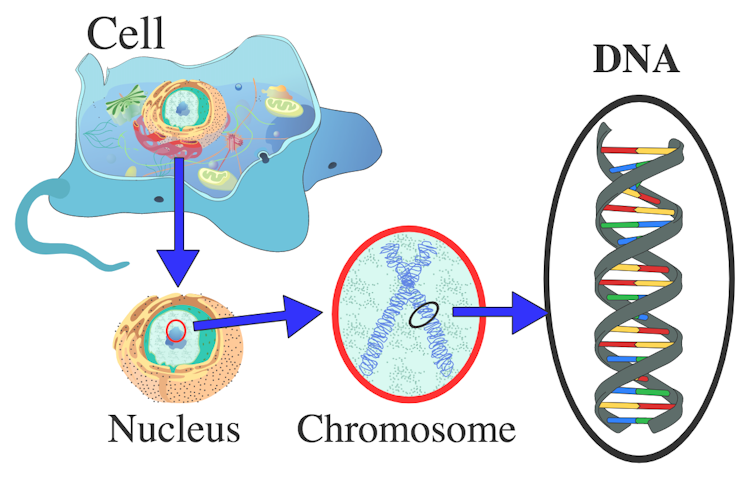Curious Kids: why do some animals have two different coloured eyes?

What a good boy. Shutterstock.
Some dogs have two different coloured eyes. Do other animals (besides people) and, if so, why? – George, aged ten, Hethersett, UK.
Some dogs are born with one brown eye and one blue eye, which can look very strange, since we’re used to seeing dogs with two brown eyes. This is sometimes called “wall eye”, and it’s caused by certain genes that are passed down from parents to offspring.
If you look closely, you’ll also see that dogs with two different coloured eyes have unusually coloured coats, too. Their coats might be dappled or streaked with white. This is because the genes for eye colour and coat colour are closely connected.
The parents themselves may not show any sign of these unusual coat or eye colours. But usually there’s at least one dog on both sides of the family tree that has the unusual colouring. That’s how the mother and father can both pass on the genes that give some of their puppies the unusual colouring.

Curious Kids is a series by The Conversation, which gives children the chance to have their questions about the world answered by experts. All questions are welcome: serious, strange or funny. Find out how to enter at the end of this article. We won’t be able to answer every question, but we’ll do our very best.
By now, you might be wondering – what are genes? Let me explain: every living thing is made up of cells. Each cell contains all the information needed to tell the body what to look like and how to work. Every little bit of information is called a “gene”, and there are lots and lots of genes which decide nearly every aspect of how we are.
Passed down from parents
For example, there are around 25,000 genes in human cells, which can decide everything from our height, to our hair colour or how likely we are to get certain diseases. The genes are made up of DNA, and held together on stringy structures called “chromosomes” in the centre of the cell.

Because every mammal comes from two parents, it has two copies of every gene – one from the mother and one from the father. Each copy may be telling the body to do something different. For example, the mother’s gene might be saying “dark hair” while the father’s says “fair hair”.
In that case, the mother’s gene will win and their baby will have dark hair, because the dark hair gene is dominant over the fair hair gene. The baby will only have fair hair if both parents pass on the gene for fair hair.
The genes for wall eye and streaky coat are similar to the fair haired gene, in this way. An animal will only have those features if that specific gene is passed down from both parents. When the mother and father carry the gene, but don’t have wall eye themselves, then some of their offspring will have it, though not all of them.
Wall eye woes

Wall eye is also sometimes seen in rabbits, cats, cattle, sheep and horses. Horses that have one blue eye usually have black and white patches on their coat – they are called “piebald” or “pinto” or “paint”. Some of these horses even have two blue eyes (one of mine does!), which makes them look even more unusual.
Humans can also have one blue eye and another of a different colour, like brown or green. This often goes with a white streak in the front of their hair.
Sometimes, having wall eye can cause problems. For dogs, the eye that is blue often has problems that can affect its sight. For this reason, breeders don’t let two dogs with wall eye and streaky coat have puppies together. If they do, then the puppies will often be blind and sometimes deaf as well.
In horses, wall eye does not seem to cause problems with vision, though having two blue eyes can be associated with deafness. Some cats and humans who have it can also have trouble hearing, and humans whose parents both have wall eye may be unable to speak or hear.
Children can have their own questions answered by experts – just send them in to Curious Kids, along wiht the child’s first name, age and town or city. You can:
- email curiouskids@theconversation.com
- tweet us @ConversationUK with #curiouskids
- DM us on Instagram @theconversationdotcom
Here are some more Curious Kids articles, written by academic experts:
-
How long has gravity existed? - Aine, aged 13, Edinburgh, UK.
-
What does it mean to be double jointed? – Gen, aged 11, Melbourne, Australia.
-
Does the sky protect the Earth and if yes, then how? – Saskia, aged eight, Estonia.

Jan Hoole, Lecturer in Biology, Keele University
This article is republished from The Conversation under a Creative Commons license. Read the original article.
Most read
Contact us
Andy Cain,
Media Relations Manager
+44 1782 733857
Abby Swift,
Senior Communications Officer
+44 1782 734925
Adam Blakeman,
Press Officer
+44 7775 033274
Ashleigh Williams,
Senior Internal Communications Officer
Strategic Communications and Brand news@keele.ac.uk.


